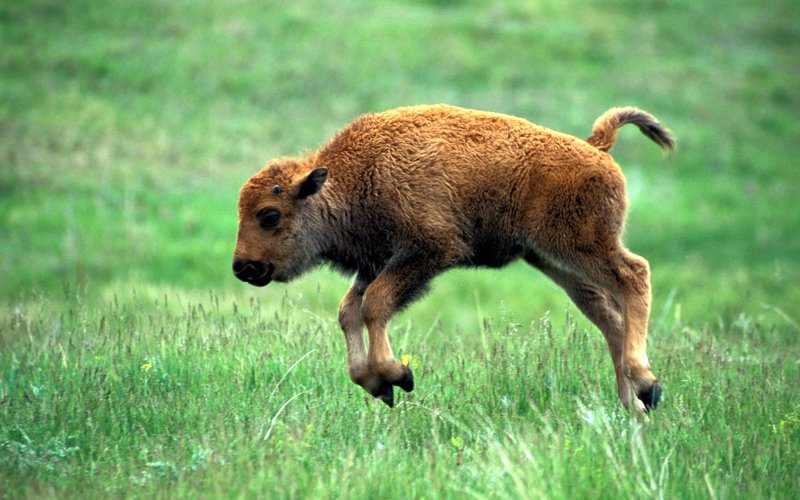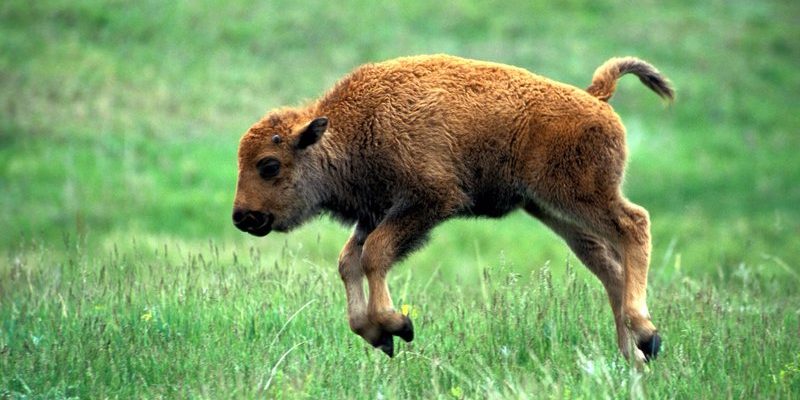
Now, imagine a mother bison, known as a cow, giving birth in the early spring when the grass is beginning to grow lush and green. The sun is shining, the air is fresh, and this little calf is stepping into a world full of wonder. The way bison raise their young is a blend of instinct, nurturing, and a dash of wildness that makes them truly remarkable. Let’s dive into their world and explore how American bisons nurture their young in the wild.
Understanding Bison Calves: The First Days
When a bison calf is born, it’s quite a sight. These calves weigh about 50-100 pounds and are able to stand and walk within a few hours. Isn’t that impressive? The first days are crucial for the little ones. They’re vulnerable and need their mother’s protection against predators like wolves and bears.
Bison cows are incredibly attentive during this period. They keep their calves close and will often move them to safe areas, away from the herd. This protective behavior is essential for the calf’s survival. You might wonder how a mother bison knows what to do. Well, it’s all instinctual. They understand the dangers around them and act accordingly.
In those early days, bonding is key. The mother and calf communicate through low grunts and body language. This connection not only strengthens their bond but also helps the calf learn the social cues of the herd. It’s like learning the rules of a game; the better they understand them, the easier life becomes.
The Role of the Herd in Bison Calf Development
You might think that raising a young one is solely the mother’s job, but in bison society, the herd plays a significant role. Bison are social animals and often stay in groups. This herd dynamic is crucial for the calves as it provides safety in numbers. Plus, the other females in the herd, known as “aunts,” help watch over the young ones.
Isn’t it comforting to know that there’s a whole team looking out for these calves? The herd moves together, grazing and migrating, which helps teach the young ones valuable lessons about survival. They learn where to find food, how to navigate their environment, and how to avoid threats.
As the calves grow, they start to engage more with other members of the herd. They play, spar, and explore, all of which are essential for their development. It’s like their version of a playground, where they learn social skills and build confidence. This shared experience is vital for their growth and helps them adapt to the wild.
Feeding and Nutrition: What Bison Calves Eat
Feeding is a big part of raising a bison calf. Initially, calves rely on their mother’s milk, which is rich in nutrients. A bison cow will nurse her calf for about 8-12 months. That’s a long time, but it’s necessary for the calf’s growth.
Once they’re a bit older, calves start to eat grass, which is their primary food source. You might wonder why grass is so important. Bison are grazers, meaning they eat vast amounts of plant matter. Good nutrition is key to helping the calves grow strong and healthy. As they explore, they learn what to eat and what to avoid, which is crucial for their survival.
Interestingly, bison have a unique digestive system that extracts nutrients from grass effectively. Their stomachs have multiple chambers, allowing them to break down tough plant fibers. This is like having a very efficient recycling system. They get the most out of what they consume, which helps them thrive in the wild.
Protection and Defense: How Bison Keep Their Young Safe
The wilderness can be a dangerous place for a young calf. So, how do bison keep their young ones safe? First and foremost, the mother is fiercely protective. If a predator gets too close, she’ll charge, using her large size and strength to fend off threats. This maternal instinct is strong and vital for the calf’s safety.
Bison also use their herd to protect the young. When they sense danger, they often form a circle around their calves, keeping them shielded from harm. Imagine a moving fortress! This behavior not only protects the calves but also teaches them how to act in threatening situations.
The bond between the cow and her calf strengthens in these moments. The calf learns to trust its mother and the herd for safety. It’s a beautiful relationship built on love, instinct, and the survival of the fittest.
Social Learning: Developing Skills and Independence
As bison calves grow, they begin to develop important skills that will help them survive in the wild. They start to mimic the behaviors of older bison. This social learning is a fascinating process, akin to how human children learn from their parents and peers.
By observing their mothers and the herd, the calves pick up essential skills like grazing, finding water, and recognizing danger. They also learn how to interact with other bison. This includes play fighting, which is crucial for strength and coordination. You might think of it as a natural gym session for calves!
As they reach about a year old, calves will start to become more independent. They still stay close to their mothers, but you’ll notice them venturing out, testing their limits, and exploring their surroundings. This gradual transition helps them prepare for adulthood, ensuring they’re ready to thrive on their own when the time comes.
Challenges and Threats: The Struggle for Survival
While the bison calf’s journey is beautiful, it’s not without challenges. The wild is full of dangers that can threaten their survival. Besides predators, environmental factors like drought or food scarcity can impact their growth.
Bison also face human-related threats. Habitat loss due to urban development and climate change significantly affects their populations. Understanding these challenges is essential for conservation efforts. There are programs aimed at protecting bison habitats and supporting their natural behaviors, ensuring future generations can thrive.
Honestly, it’s a reminder of how interconnected our ecosystems are. Every species, including bison, plays a role in maintaining balance. By protecting them, we’re not just saving a species; we’re also preserving a piece of our natural heritage.
Raising young bison in the wild is a multifaceted journey filled with love, learning, and survival. From the moment they are born, these calves rely on their mothers and the herd to guide them through a challenging but enriching early life. With the right mix of protection and social interaction, they develop into strong, independent adults ready to face the wild.
So next time you think of American bisons, remember the story of the calves. It’s not just about grazing on the plains; it’s about a community that nurtures and protects its young. By understanding their ways, we appreciate the beauty of nature and the importance of conservation. Every calf that grows strong and healthy adds to the legacy of these magnificent creatures. Isn’t that a wonderful thought?

